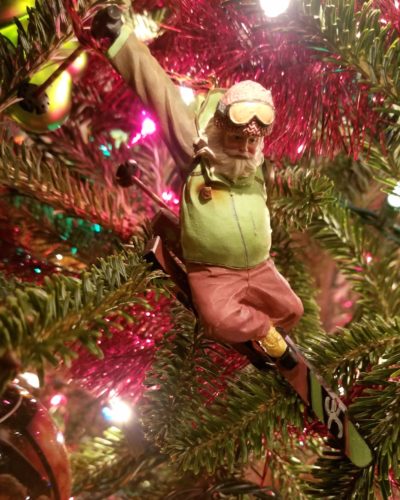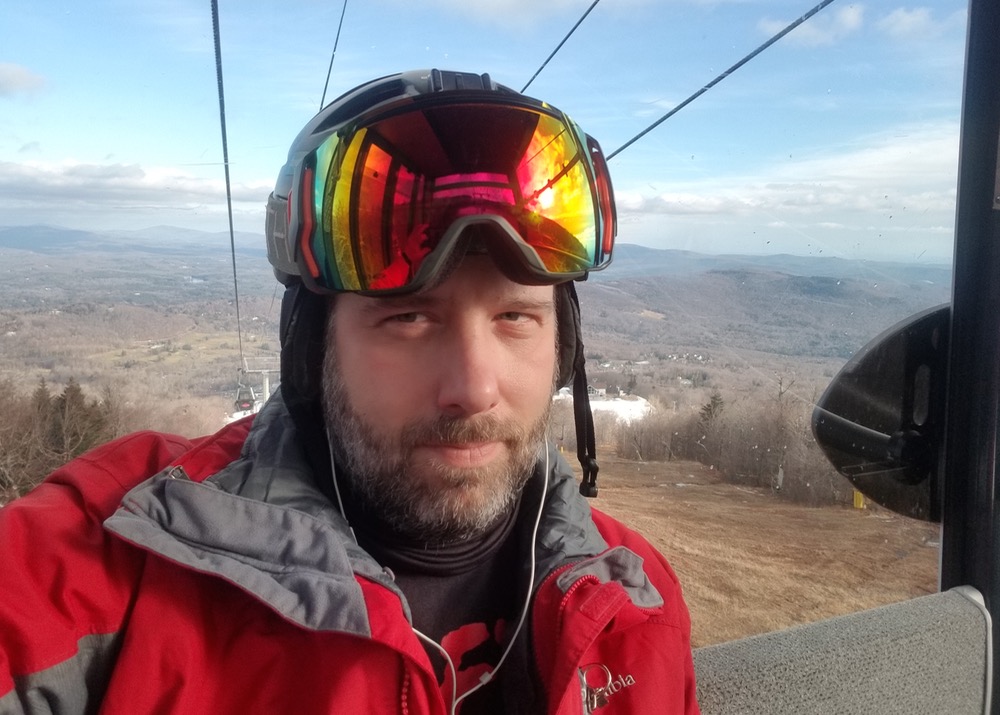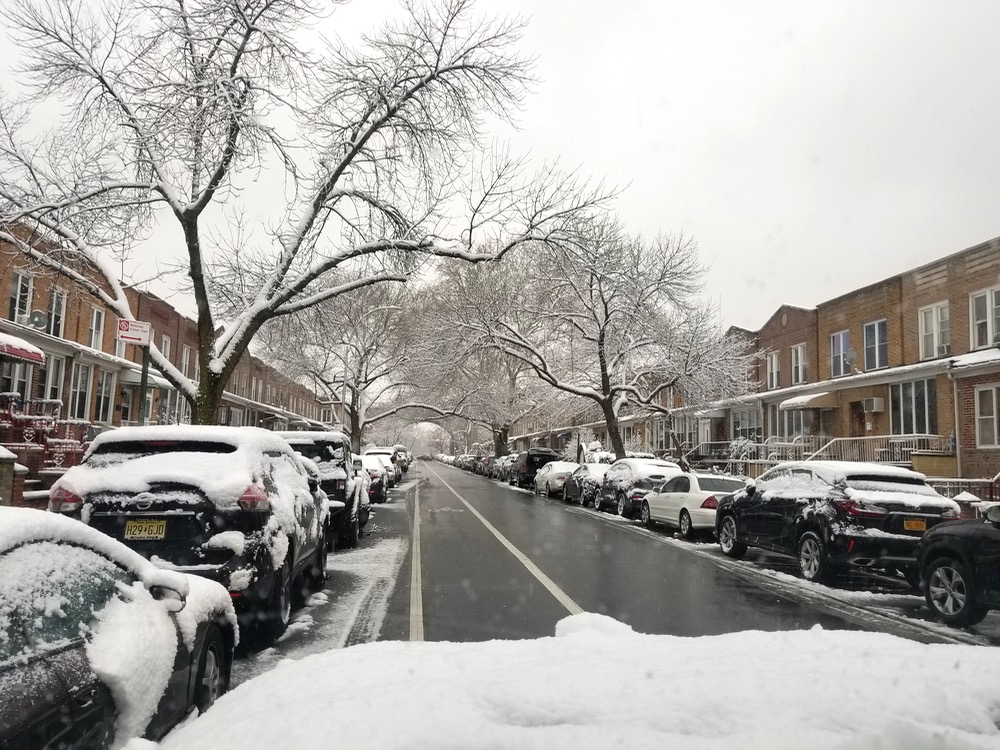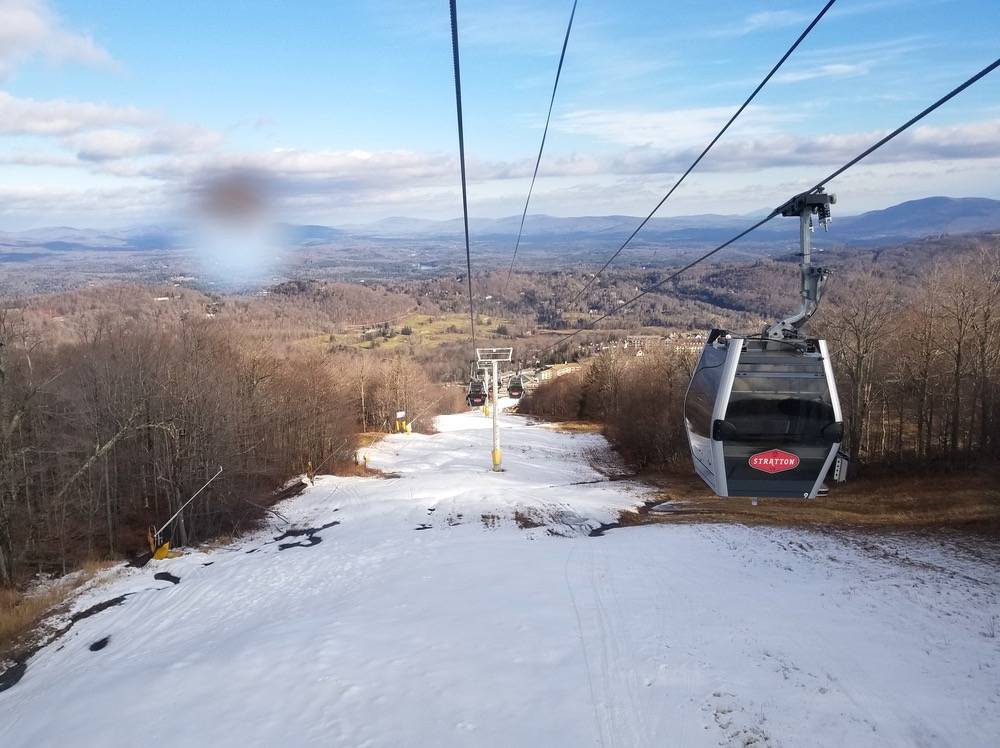 It happened too fast to process. One moment I was carefully navigating frozen boilerplate on Upper Tamarack at Stratton, and the next I had hit a patch of sticky fresh manmade snow beneath the bellowing guns. I was tossed forward off my skis and into a trailside tree at almost 30 miles per hour.
It happened too fast to process. One moment I was carefully navigating frozen boilerplate on Upper Tamarack at Stratton, and the next I had hit a patch of sticky fresh manmade snow beneath the bellowing guns. I was tossed forward off my skis and into a trailside tree at almost 30 miles per hour.
I was dimly aware of my body wrapping around the trunk sideways, getting boomeranged back and sliding ten feet further down. I was screaming louder than I’ve ever yelled in my adult life, certain that I’d be carried off the slope on a stretcher. I felt things break inside. But as I spun to a stop, I realized that my cries were inaudible beneath the roar of blasting snow guns – not that there was anyone to hear me.
I was completely alone on an icy Wednesday morning in early December, high up on a trail devoid of other skiers. Panic set in, and I began to wonder how I would be able to explain all this to my wife, who was never a big fan of my burgeoning ski obsession, or of winter for that matter. I felt guilty and I found myself missing her fiercely. I seriously wondered if I’d be able to walk again.
But I’m getting ahead of myself; let me back up and explain what led to my predicament.
Exactly three years earlier, to the day, I’d started in on my new skiing obsession in earnest on an early season trip to Killington. I’ve skied exactly 224 days since then, at 77 different ski areas in four different countries. What began as grist for a series of posts for my Forbes.com travel blog had blossomed into a feverish and slightly insane quest to be as badass a skier as was possible in my forties. Every day was an opportunity to learn and improve, and it was all going into the book I’d been – and still am – writing.
In the process I’d incurred my fair share of injuries – a cracked rib here, a pulled thumb there, and punished my knees. I’d long ago achieved a zen-like outlook on injury; I knew I’d fallen in love with a risky sport and that there would be times when my mistakes would be painful. Advil and whiskey were indispensable friends throughout the process – one does not simply go from sedentary to full send without collecting a few bumps and bruises.

But this was different. Laying there on that barren, frozen trail in southern Vermont on a morning in which rain had been forecast, I knew that I had wiped out worse than all of the other times combined, and looking around I knew that it was unlikely that anyone else would be passing me any time soon. There were maybe 25 other people on the mountain that day, and I’d already seen the bulk of the early-morning regulars hang it up for the day. But despite the less-than-favorable conditions, I’d been lapping the gondola all morning. After all, this was what I woke at 3 am and drove four hours north from Queens to do. I hadn’t shared a lift the entire morning, and I couldn’t have been happier.
Of course, that all changed with one tree. I pushed the panic down and assessed the situation: I knew I was hurt, but I had no idea how badly. There was no blood visible; that was good. But I worried about what I couldn’t see, and I immediately began to visualize the internal damage could result from a 30-mph collision with a tree. If I was bleeding somewhere inside, there was no way to tell how bad it was, or indeed how long it would be until I lost consciousness.
I missed my wife. All I could think about was getting back to her, and I worried the longer I lay there the less likely that was to happen. I calmed myself and crawled uphill to where my skis had stopped after getting ripped off my feet.
“I gotta get up I gotta get up I gotta get up,” I mantra-grunted over and over to myself, like some sad-ass drill sergeant. “You can do this, John. You got this. All you have to do is make it down to the bottom and you can get help there.” I was determined not to be some statistic whose story would be told in a brief and misspelled post on the Unofficial Networks or SnowBrains Facebook pages. I was determined not to go out like a bootleg Sonny Bono.
I was able to click back into my bindings and fight my way back down to the base. I gathered my gear, changed out of my ski boots lest I wipe out on the walk to the clinic, and made my way toward the first aid station.
The nurse apologized for the empty emergency room – it was too early in the season for the clinic to be fully staffed, and if I was going to see a doctor that day it would be at the end of an ambulance ride. By that point, I had gathered my wits and realized that I was able to walk without too much pain, though I knew something was definitely wrong inside. She checked me out and said that since I was able to get back down on my own power that I was probably going to be okay, though she couldn’t guarantee that I hadn’t broken a rib.
I’ve suffered cracked ribs before, and I knew that there’s really not much to be done about them other than let them heal. I told her I’d gone to the bathroom since the accident and that things looked normal. She told me it was my decision: call an ambulance and get taken to a hospital in southern Vermont – four hours away from the person I most wanted to be with in the world at that point – or carefully make my way home.
I chose the second option. The nurse told me that if I started to run a fever or if there was blood anywhere that blood shouldn’t be, I should immediately go to the emergency room, and I promised that I would. I was able to carry my gear back to my Jeep, load my skis into my rooftop cargo box, and start the long drive back to New York City. I also resolved not to tell Hilary what had happened until I returned home or unless I absolutely needed to. I didn’t want her to worry and be stuck in a position where she could do nothing about it, and I didn’t want to have to explain to her why I’d only spent about five minutes debating whether to give up skiing for good before deciding that would be an epic life mistake.
So I gritted my teeth and drove south. Hilary gave me the requisite what-for when I returned home, but I assured her that I would be fine. After all, I knew from cracked ribs, and besides, I’m strong like bull.
I knew I was out of the game for a while, but at that point I had no idea how long my exile would be. And when, 48 hours later, I began to run an elevated temperature, I finally decided to make my way to the emergency room to see a doctor.

Two x-rays and one CT scan later, I discovered that I had fractured two of the lower ribs on my left side – ribs 10 and 12 – and I also found out what was causing my temperature to spike. I was told that I had ruptured the lowest of the three arteries that feed my left kidney, and as a result the lower portion of the kidney had been starved of oxygen and was necrotic. Quite the word, that: “necrotic.” I would spend the rest of my days with a shriveled, vestigial kidney tail hanging on at the bottom, but was assured that if everything healed properly I should regain full renal function in time.
As a fun little aside, my CT scan had also turned up an unidentifiable spot and that I’d need to be admitted to the hospital to schedule an MRI that would be able to more accurately analyze this new complication. My relief at my relatively lucky diagnosis morphed into a paralyzing fear that I was about to be diagnosed with something too scary to contemplate.
Thankfully, luck seemed to be on my side yet again, as the MRI scan revealed that the spot was the remnant of an old surgery and not a tumor death sentence. Nevertheless, it was one of the scariest days of my life, full of regret for mistakes made, relationships neglected, and mountains left un-skied.
I asked the doctor how long I’d have to stay off skis and was told at least six weeks – and that I should consider myself very lucky. Indeed, if I had hit that tree at a slightly different angle, I’d be writing from a wheelchair, or being fitted for a coffin. I agreed: I am insanely lucky.

Somehow, I remain undeterred, counting the days until I can boot up again.
I’ve approached this sport with a clear-eyed view of what can go wrong, and indeed the process of doing research for a book about skiing has made me keenly aware of all the things that can and do go wrong on the hill regularly. I’ve been sanguine about most of the dangers, but I remain terrified of two main nightmares that are inherent in skiing.
The first – suffocation in a tree well or at the bottom of an avalanche – has scared me enough that I’ve promised myself I won’t venture further into the backcountry without the requisite gear (beacon, probe, and shovel are the bare minimum), and I hope to take my Avy 1 course later this winter. But these are dangers faced mainly by western skiers, and I’ve been very careful not to venture into steep and deep western terrain alone.
My second skiing nightmare – losing an edge and colliding with a tree at high speed – was the one whose dangers I knew I’d been most at risk of encountering in the east. I know that the majority of on-mountain deaths are attributable to impacts with trees, and I’m also aware that I’m a member of the demographic group most likely to die as a result of hitting a tree – male skiers in their 20s to 50s who lose control and get wrapped around a tree.
Despite my love for speed, I’ve tried to be careful about growing over confident on the mountain, and I’ve done my best to mitigate the risks. But when my ski nightmare came to life and bit me in the ribs, it happened too fast for me to realize it was happening. That might be the biggest nightmare of all – that it could all end before I knew it was over.

If I’ve learned anything it’s that the dangers of this sport are real and it’s on each of us to educate ourselves about them and do our damndest to make sure we don’t become statistics. There’s no way to banish risk from skiing, but experience should teach us what we’re comfortable skiing and what we aren’t, and we should listen to our inner paranoiac.
So what if I’m stuck at home until late January, jealously scanning my social media feeds and watching all the fun others are having at the beginning of this epic East Coast season? I’m ambulatory, and I’m alive.
After getting a tattoo of Ullr on my calf in the summer of 2016, and after benefitting from a winter where I was skiing powder from New York to British Columbia, I theorized that Ullr is a kind and generous god – as long as he receives a blood offering. And when I broke my ribs and banged up my kidney, I became convinced that Ullr gives back if he receives his due early in the season. I do hope that in the future I won’t have to bear the burden of feeding a bloodthirsty snow god alone. I mean, I love powder as much as the next guy, but I only have so much kidney to give.
So if you’ve been enjoying these early season goods…you’re welcome. And if you happen to run into me and you recognize me from this post, thank me or better yet, buy me a beer, the way this season is starting I think you owe me. Stay safe out there, and watch out for those guns. They can make a season, but they can also break a body.


Great report, probably the best I’ve read here. Sublime quotes, “mountains left un-skied”, “it could all end before I knew it was over”. I always kick off my ski days by telling myself to stay alive today, and then chuckle. After reading this, it doesn’t seem so funny anymore.
Really sorry that happened to you, glad you have a sense of humor about things. My bro fractured some ribs while we were skiing the Tahoe backcountry in 2012, hopefully you’re back at it as quickly as he was.
Great story. Hopefully, with age comes wisdom and caution as we realize that an injury can be life altering. A younger person doesn’t have this insight. Too often I’ve witnessed young men, usually 15-40 years old, skiing way to fast on boilerplate. You know, the 3 turn guy on Hawkeye, or the 4 turn guy on Lies. Or the 75 mph guy on Northway during snowstorm. life is full of risks but you don’t have to tilt the odds in favor of the grim reaper with poor decision making. I hope your story leads readers to insight and self introspection. Hey, the goal is to ski forever.
Wow. Sorry you went through that, man. Hope you heal up quickly.
What a story and glad you made it home and to the hospital. Necrotic anything is a really scary thing – though it sounds like the prognosis will right itself. Hoping for sure that you have a speedy recovery and that when you return, there will be plenty of snow.
Hard to think, year ago my wife had a bad fall. Not sure how bad she was injured, we eventually learned, no broken bones, though she tore her ACL…
Not sure if you have seen our web series – though if you haven’t – here is our XMAS episode from last season –
http://forum.nyskiblog.com/Pico-VT-12-25-26-and-Okemo-VT-12-13-td4097562.html
Heal up and take your time on the slopes and rebuild the confidence..
Best,
Ray and Alicia Alba
I don’t want to sound like an ass but we need to assess the conditions. In the NE their is most likely a patch of ice lurking somewhere under the snow. The later in the day the more likely. Please be careful out there.
Great piece. Chapeau for your presence of mind to get back down the mountain. Best wishes for complete recovery.
Thanks for the kind words, everyone. I’ve definitely learned some lessons about conditions I’m not comfortable in, and about taking it easy on the proverbial white ribbons of death – not that I wasn’t taking it easy that day. But unfortunate things happen, and my injuries could have been much worse, so I feel incredibly fortunate.
Thankfully, I’m healing up on schedule, I should retain most of my kidney function, and I’m finally able to sleep on my left side again, so I’m looking forward to rejoining you all on the mountains in about a month. In the meantime, enjoy Ullr’s largesse, and steer clear of that wet gun snow on top of frozen boilerplate. That stuff is evil!
Heal up John, great perspective around an unfortunate event that we all fear.
I connected with you on Twitter bc we both had the epiphany in the Winter of 12/13 – stoked and jealous to see your stats (277 days!). I have maybe 80 over that time. Kids!
All the best, and as someone who frequently day trips to Killington, alone, as foolish as it is, let’s connect when you’re on the mend!
@trailsr
The part that chills me the most is the self-rescue, getting down the hill without help. I tore a hamstring midweek and noone was around. It took me over 90 minutes to get back to the main base area “skiing” on one leg, in a foot of mank. I also quickly got into survival mode, talking to myself to stay calm, I’ll never forget it.
Get well JG!